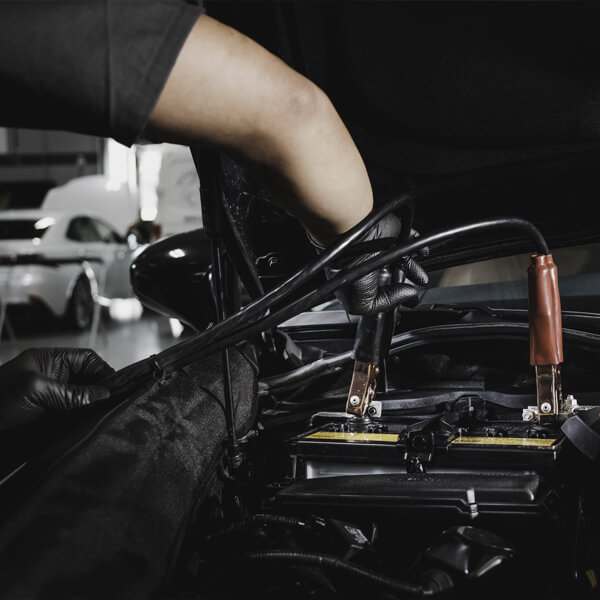Car Batteries in Edmonton

Taking care of your battery can help get the most service life from it, and being attentive to its condition and age can signal when it is time to begin shopping for a replacement… before you are left stranded.
Be Proactive
Being attentive to your battery's maintenance and mindful when the time for replacement is approaching will ensure that you can choose a replacement on your own terms, including properly researching and conveniently scheduling.
Test Batteries Annually
Inspections should be part of an owner's routine maintenance, but it is especially important to check before taking a long road trip. Car batteries typically last from three to five years. While almost all of today's car batteries are "maintenance-free," we recommend having your battery load-tested by a mechanic annually once it is 2 years old if you live in a warmer climate or 4 years old if you live in a colder climate. Doing so tests its ability to hold voltage while being used, and the results will let you know when it’s time to start shopping.
Make Sure It's a Fresh Battery
Batteries lose strength over time, even when in storage. For optimum performance, purchase one that is less than 6 months old. Three months is even better. Most have a shipping code on the case. Some use a letter for the month ("A" for January) and a number for the year ("9" for 2019); others use a numeric date.
Recycle Your Old Battery
A battery's toxic lead and acid can easily be recycled, and most retailers will dispose of the old one for you. When buying a new battery at a store, you will probably pay an extra charge that will be refunded when you return the old battery.
Get to Know the Battery Types
Car batteries come in two basic varieties: the more traditional maintenance-free and the more advanced absorbed glass mat (AGM).
Lead-Acid (Regular)
Batteries once required drivers to periodically top off the water in the electrolyte solution, the liquid inside that is the battery’s power source. Modern maintenance-free batteries consume far less water than traditional “flooded cell” ones. Low-maintenance batteries retain their fluid for the life of the battery, and the caps on these models aren’t meant to be removed. There are still some batteries than can be topped off with distilled water; properly maintained, these may last longer in hot climates. A lead-acid battery will generally cost significantly less than an absorbed glass mat battery. However, it will not hold a charge for as long and is less able to tolerate a deep discharge.
Absorbed Glass Mat (AGM)
AGMs are built to better stand up to repeated draining and recharging cycles than standard batteries. They are becoming standard equipment in more cars because modern features such as fuel-saving stop-start systems, electronic safety and convenience features, and power outlets for mobile electronics all increase the demand for power. But AGMs can cost 40 to 100 percent more than highly rated conventional batteries. Consider buying one if you sometimes don’t use your vehicle for long periods and the battery loses its charge. An AGM battery can better tolerate a deep discharge, and it is more likely to fully recover if it is accidentally drained.
Get the Right Fit
Batteries come in a variety of sizes. It’s important to choose the right one to ensure that it fits securely and provides sufficient power. If the terminals are in the wrong place, your car’s cables might not reach or they might not fit securely. Check your owner’s manual or an in-store fit guide. Many retailers will install the battery free of charge.
Size 24/24F (top terminal): Fits many Acura, Honda, Infiniti, Lexus, Nissan, and Toyota vehicles.
Size 34/78 (dual terminal): Fits many large Chrysler vehicles and many 1996 to 2000 GM pickups, SUVs, and midsized and large sedans.
Size 35 (top terminal): Fits most Japanese nameplates, including many recent Honda vehicles and most Nissan, Subaru, and Toyota vehicles.
Size 47 (H5) (top terminal): Fits many Buick, Chevrolet, Fiat, and Volkswagen models.
Size 48 (H6) (top terminal): Fits many European as well as American vehicles from Audi, BMW, Buick, Cadillac, Chevrolet, GMC, Jeep, Mercedes-Benz, Mini, Volkswagen, and Volvo.
Size 49 (H8) (top terminal): Fits many European and Asian vehicles from Audi, BMW, Hyundai, and Mercedes-Benz.
Size 51R (top terminal): Fits many Japanese vehicles from Honda, Mazda, and Nissan.
Size 65 (top terminal): Fits large cars, trucks, and sport-utility vehicles from Ford or Mercury.
Size 75 (side terminal): Fits some General Motors midsized and compact cars and a few Chrysler vehicles.

Where In Edmonton Can I Get A Battery If Needed?
Regular battery tests are important to confirm that your battery has sufficient charge to start the vehicle and maintain the use of accessories. A weak battery in cold conditions can lead to a no-start/boost requirement. Replacement starting at $230.00 plus gst (includes installation). Test the strength of your battery with an AVR (Amperage, Voltage, & Resistance test) $77.00 plus gst.
Request an appointment with our Service Department by filling out the form. We will confirm your appointment with you within 24 hours of receiving your request. Please note that your confirmation will come during regular business hours Monday – Friday. For same day appointments, please contact us Toll Free directly at 1-866-936-8300 or locally at 780-784-0550 or email us at appointments@lexusofedmonton.ca





















